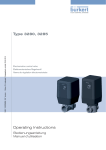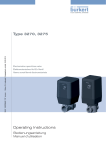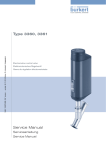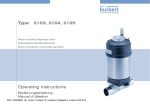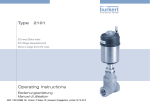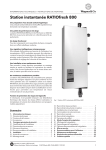Download Operating Instructions Type 3270, 3275
Transcript
Type3270, 3275 Electromotive open/close valve Elektromotorisches Auf-Zu-Ventil Vanne ouvert/fermé électromotorisée Operating Instructions Bedienungsanleitung Manuel d‘utilisation We reserve the right to make technical changes without notice. Technische Änderungen vorbehalten. Sous réserve de modifications techniques. © 2015 Bürkert Werke GmbH Operating Instructions 1505/00_EU-ML_00810399 / Original DE Type 3270, 3275 Electromotive open/close valve Type 3270, 3275 Contents 1 2 Operating instructions.........................................................................................................................................................5 1.1 Symbols.......................................................................................................................................................................................5 1.2 Definition of terms..................................................................................................................................................................5 Authorized use..............................................................................................................................................................................6 2.1 Restrictions................................................................................................................................................................................6 3 Basic safety instructions..................................................................................................................................................7 4 General information.................................................................................................................................................................8 5 6 4.1 Contact address......................................................................................................................................................................8 4.2 Warranty.......................................................................................................................................................................................8 4.3 Information on the Internet................................................................................................................................................8 System description....................................................................................................................................................................9 5.1 Intended use..............................................................................................................................................................................9 5.2 General description...............................................................................................................................................................9 5.3 Designs........................................................................................................................................................................................9 5.3.1 Electromotive stroke valve Type 3270............................................................................................10 5.3.2 Electromotive disk valve Type 3275................................................................................................10 Technical data..............................................................................................................................................................................11 6.1 Conformity...............................................................................................................................................................................11 6.2 Standards.................................................................................................................................................................................11 6.3 Operating conditions.........................................................................................................................................................11 6.4 Mechanical data....................................................................................................................................................................12 6.5 Electrical data........................................................................................................................................................................12 6.5.1 Derating.................................................................................................................................................13 6.6 Fluidic data..............................................................................................................................................................................13 6.7 Type label.................................................................................................................................................................................14 3 english Type 3270, 3275 7 Installation....................................................................................................................................................................................15 7.1 Safety instructions..............................................................................................................................................................15 7.2 Fluid installation...................................................................................................................................................................15 7.3 Electrical installation..........................................................................................................................................................16 7.4 DIP switch settings.............................................................................................................................................................17 7.5 8 10 Setting the DIP switch for Type 3270............................................................................................18 7.4.2 Setting the DIP switch for Type 3275............................................................................................20 LED display..............................................................................................................................................................................22 Start-up..............................................................................................................................................................................................23 8.1 9 7.4.1 Functions..................................................................................................................................................................................23 Maintenance, troubleshooting..................................................................................................................................24 9.1 Safety instructions..............................................................................................................................................................24 9.2 Maintenance...........................................................................................................................................................................24 9.3 Cleaning....................................................................................................................................................................................24 9.4 Troubleshooting....................................................................................................................................................................24 Spare parts.....................................................................................................................................................................................26 10.1 Accessories.............................................................................................................................................................................26 11 Packaging and transport................................................................................................................................................27 12 Storage...............................................................................................................................................................................................27 13 Disposal.............................................................................................................................................................................................27 4 english Type 3270, 3275 Operating instructions 1 Operating instructions The operating instructions describe the entire life cycle of the device. Keep these instructions in a location which is easily accessible to every user, and make these instructions available to every new owner of the device. Important safety information. Read the operating instructions carefully and thoroughly. Study in particular the chapters entitled “Basic safety instructions” and “Authorized use”. ▶▶The operating instructions must be read and understood. 1.1 Symbols Danger! Warns of an immediate danger! ▶▶Failure to observe the warning may result in a fatal or serious injury. Warning! Warns of a potentially dangerous situation! ▶▶Failure to observe the warning may result in serious injuries or death. Caution! Warns of a possible danger! ▶▶Failure to observe this warning may result in a moderate or minor injury. Note! Warns of damage to property! • Failure to observe the warning may result in damage to the device or the equipment. Indicates important additional information, tips and recommendations. Refers to information in these operating instructions or in other documentation. →→Designates a procedure which you must carry out. 1.2 Definition of terms In these instructions the term “device” always refers to the electromotive open-close valve Type 3270 and 3275. 5 english Type 3270, 3275 Authorized use 2 Authorized use Non-conforming use of the electromotive open/close valve Type 3270 and 3275 may be a hazard to people, nearby equipment and the environment. ▶▶The electromotive open/close valve is designed to control the flow of non-aggressive, clean and non-corrosive liquid and gaseous medium. ▶▶Do not use the device outdoors. ▶▶Do not expose the valve to direct sunlight. ▶▶Use Type 3270 and 3275 only in conjunction with third-party devices and components recommended and authorized by Bürkert. ▶▶The device must be used in compliance with the characteristics and commissioning and use conditions specified in the contractual documents and in the user manual. ▶▶Use the open/close valve only when in perfect condition and always ensure proper storage, transportation, installation and operation. ▶▶Only use the device as intended. 2.1 Restrictions If exporting the device, observe any existing restrictions. 6 english Type 3270, 3275 Basic safety instructions 3 Basic safety instructions These safety instructions do not make allowance for any • contingencies and events which may arise during the assembly, operation, and maintenance. • local safety regulations – the operator is responsible for observing these regulations, also in relation to the installation personnel. Risk of injury from high pressure. ▶▶Before loosening lines and valves, cut off the pressure and deaerate/ drain lines. Risk of injury due to electrical shock. ▶▶Before working on the system or device, switch off and isolate the power supply to prevent reactivation of the device. ▶▶Observe applicable accident prevention and safety regulations for electrical equipment! Risk of burns or risk of fire if used for a prolonged duty cycle through hot device surface. ▶▶Keep the device away from highly flammable substances and medium and do not touch with bare hands. General hazardous situations. To prevent injuries: ▶▶Do not use Type 3270 and 3275 in potentially explosive areas. ▶▶Do not subject the actuator housing and actuator cover to mechanical loading. ▶▶Do not make any internal or external modifications on the device. Do not paint housing parts or screws. ▶▶Avoid using the open/close valve in the vicinity of strong magnetic fields. ▶▶Secure the device from unintentional actuation. ▶▶Only trained technicians may perform installation and maintenance work. ▶▶After an interruption in the power supply, ensure that the process is restarted in a defined or controlled manner. ▶▶Observe the general rules of technology. Note! Electrostatic sensitive components and modules! The device contains electronic components which react sensitively to electrostatic discharge (ESD). Contact with electrostatically charged persons or objects are hazardous to these components. In the worst case scenario, they will be destroyed immediately or will fail when energized. • Observe the requirements in accordance with EN 61340-5-1 to minimize or avoid the possibility of damage caused by sudden electrostatic discharge! • Do not touch electronic components while the supply voltage is switched on! 7 english Type 3270, 3275 General information 4 General information 4.1 Contact address Germany Bürkert Fluid Control Systems Sales Center Christian-Bürkert-Str. 13-17 D-74653 Ingelfingen Tel. + 49 (0) 7940 - 10 91 111 Fax + 49 (0) 7940 - 10 91 448 E-mail: [email protected] International Contact addresses are found on the final pages of the printed operating manual. You can also find information on the Internet under: www.burkert.com 4.2 Warranty The warranty is only valid if the electromotive open/close valve Type 3270 and 3275 is used correctly in accordance with the specified operating conditions. 4.3 Information on the Internet The operating instructions and data sheets for Types 3270 and 3275 can be found on the Internet at: www.burkert.com 8 english Type 3270, 3275 System description 5 System description 5.1 Intended use The electromotive open/close valve Type 3270 and 3275 is designed to control the flow of non-aggressive, clean and non-corrosive liquid and gaseous medium. Only clean, liquid or gaseous medium, which does not attack the bodies and sealing materials, may be controlled. Note! Unsuitable medium will damage the body and the seals! Unsuitable medium may damage the body and the seals. • Use suitable medium only. • Check chemical compatibility in individual cases. 5.2 General description The valve is switched with the aid of a stepper motor drive which is controlled via the control electronics. Therefore, no external motor control is required. Basic functions of the control electronics: • Switching on/off the valve is by processing the signal • Output of the valve states via the LED display • Position detection after power failure - if the power fails, the current position of the valve is retained - when the power is restored, the internal control electronics automatically detects it’s current position • Reduction in the energy consumption - The valve is designed to hold its position without the active use of the motor. As soon as the desired position is achieved, motor is turned off and the valve uses only fraction of power required to move the valve. 5.3 Designs The following versions of the electromotive valve are available: • electromotive 2/2-way stroke valve Type 3270 (DN2, DN3, DN4, DN6) • electromotive 2/2-way disk valve Type 3275 (DN8, DN10, DN12, DN15, DN20, DN25) 9 english Type 3270, 3275 System description 5.3.1 Electromotive stroke valve Type 3270 The valve spindle is driven by a stepper motor. The angular movement of the motor is converted to translational movement with the aid of a threaded spindle. The valve spindle is connected rigidly to the threaded spindle. The valve spindle is connected to a piston. The valve seat is sealed by an elastomer seal. Linear stepper motor Control electronics Threaded spindle Valve spindle Elastomer seal Piston Body Figure 1: Electromotive stroke valve Type 3270 5.3.2 Electromotive disk valve Type 3275 The disk valve consists of a stepper motor with gearbox which transfers the rotational torque to the actuator shaft via coupling. The actuator shaft has control disc attached to it. A fixed disk with a mouth attached to the body is used as a valve seat. The shut-off disc is pressed onto the fixed disk by a supporting spring. The fixed disc and the shut-off disc are positioned in such a way that the rotational movement of the shut-off disc opens or closes the valve seat. Control electronics Stepper motor with gearbox Coupling Actuator shaft Spring Fixed disc Control disc Body Figure 2: Electromotive disk valve Type 3275 10 english Type 3270, 3275 Technical data 6 Technical data 6.1 Conformity The electromotive open/close valve Type 3270 and 3275 is compliant with EC directives as stated in the EC Declaration of Conformity. 6.2 Standards The applied standards, which are used to demonstrate compliance with the EC Directives, are listed in the EC type test certificate and/or the EC Declaration of Conformity. 6.3 Operating conditions Warning! Risk of injury due to malfunction if device used outdoors. ▶▶Do not use the device outdoors and avoid heat sources which may cause the permitted temperature range to be exceeded. ▶▶Protect the device from direct sunlight and humidity. Permitted temperatures Ambient temperature -10 to +60 °C (observe derating curve, see chapter “6.5.1”) Medium temperature 0 to +70 °C Medium temperature for oxygen 0 to +60 °C Permitted air humidity Air humidity< 95 %, non-condensing Authorized medium Medium non-aggressive, clean and non-corrosive liquid and gaseous medium which do not attack the bodies and sealing materials. Check resistance in individual cases (see chemical resistance chart at www.burkert.com). If medium is contaminated or contain particals, connect a suitable dirt filter upstream. Control functionsDepending on the version, the seat of the valve is closed with or against the medium flow: Type 3270: flow direction under seat Type 3275: flow direction over seat Circuit function A 2/2-way valve for continuous control of the flow rate in output A, motorized, without power motionless M P 11 english Type 3270, 3275 Technical data 6.4 Mechanical data Materials Type 3270 Type 3275 Actuator housing Black Plastic parts: PPS GF40, Anthracite Plastic parts: PC GF10 Black Plastic parts: PPS GF40, Anthracite Plastic parts: PC GF10, in contact with medium: PPS GF40 Body Brass (MS) or Stainless steel (VA) Brass (MS) or Stainless steel (VA) Sealing material FKM, NBR or EPDM FKM or NBR, technical ceramic Other materials in the fluid area Stainless steel (VA) Stainless steel (VA) Connections Type 3270 G 1/4, G 3/8, NPT 1/4 or NPT 3/8 Type 3275 G 1/2, G 3/4, G 1, NPT 1/2, NPT 3/4 or NPT 1 Weight Type 3270 ~ 0.7 kg (with VA body) Type 3275 DN8/10 ~ 0.8 kg (with VA body) DN12/15 ~ 1.2 kg (with VA body) DN20/25 ~ 1.5 kg (with VA body) Dimensions 6.5 see data sheet Electrical data Electrical data Type 3270 Type 3275 Connections circular plug-in connector (M12 x 1, 8-pole) circular plug-in connector (M12 x 1, 8-pole) Supply voltage 24 V DC ±10 % residual ripple < 10 % 24 V DC ±10 % residual ripple < 10 % Power consumption max. 8 W max. 12 W Standby power consumption approx. 1 W approx. 1 W Actuating time (0...100 %) approx. 2.5 s, for setting “Valve actuating speed normal”, see chapter “7.4” approx. 4 s, for setting “Valve actuating speed normal”, see chapter “7.4” Binary input (set-point value input) 0...5 V = log „0“, 10...30 V = log „1“ 0...5 V = log „0“, 10...30 V = log „1“ Binary output active, max. 100 mA current limitation, PNP, switching voltage = Usupply-1 V, short-circuit proof active, max. 100 mA current limitation, PNP, switching voltage = Usupply-1 V, short-circuit proof Limit switch contactless end position detection contactless end position detection Duty cycle a s per EN 60034-1: S3 50%, depending on the operating conditions. Observe derating curve, see chapter “6.5.1” as per EN 60034-1: S3 50%, depending on the operating conditions. Observe derating curve, see chapter “6.5.1” 12 english Type 3270, 3275 Technical data 6.5.1 Derating Duty cycle [%] The maximum duty cycle of the valve depends on the maximum ambient temperatures and the current required by the stepper motor. The derating curve can be used to indicate the maximum duty cycle permissible at the corresponding ambient temperature. By switching on the low power function a higher duty cycle can be achieved (Warning: during low power function, max medium pressure is reduced; if violated Valve will not move or malfunction). 100 90 80 70 60 50 40 30 20 10 Normal operation Low power function 5 10 15 20 25 30 35 40 45 50 55 60 65 70 Max. ambient temperature [°C] Figure 3: Derating curve 6.6 Fluidic data Definition DN DN designates the orifice of the seat, not the orifice of the port connection. Type 3270 Orifice DN 2 3 4 6 3275 8 10 12 15 20 25 1) Port connection G 1/4 NPT 1/4 G 1/4 NPT 1/4 G 3/8 NPT 3/8 G 3/8 NPT 3/8 G 1/2 NPT 1/2 G 1/2 NPT 1/2 G 3/4 NPT 3/4 G 3/4 NPT 3/4 G1 NPT 1 G1 NPT 1 KVs-value [m³/h] 1) 0.15 0.15 0.3 0.3 0.5 0.5 0.9 0.9 1.8 1.8 2.5 2.5 3.9 3.9 6.0 6.0 8.8 8.8 12.3 12.3 Max. pressure for flammable gases [bar] 3 3 3 3 3 3 3 3 3 3 3 3 3 3 3 3 3 3 3 3 Max. pressure [bar] 6 6 6 6 6 6 6 6 6 6 6 6 6 6 6 6 6 6 6 6 The KVs value is a flow rate value for water, measurement at +20 °C and 1 bar pressure difference above the fully opened valve. english 13 Type 3270, 3275 Technical data 6.7 Type label Body material Sealing material Nominal diameter D-74653 Ingelfingen Type 3270 X DN25 EPDM MS NPT 1/4 PN 6 bar 24 V DC 8 W Tamb see manual 268611 Identity number, Serial number Ambient temperature Voltage, Max. power consumption Port connection, Pressure range Figure 4: Description of the type label (example) 14 english SN000000 W3ZLT Type 3270, 3275 Installation 7 Installation 7.1 Safety instructions DANGER! Risk of injury from high pressure in the system or device. ▶▶Before working on the system or device, cut off the pressure and deaerate/drain lines. Risk of injury due to electrical shock. ▶▶Before working on the system or device, switch off the power supply and secure to prevent reactivation. ▶▶Observe applicable accident prevention and safety regulations for electrical equipment. Warning! Risk of injury from improper installation. ▶▶Installation may be carried out only by trained technicians and with the appropriate tools! ▶▶Secure system against unintentional activation. ▶▶Following installation, ensure a controlled or defined restart. 7.2 Fluid installation DANGER! Risk of injury from high pressure in the system or device. ▶▶Before working on the system or device, cut off the pressure and deaerate/drain lines. Installation position: any position, preferably with actuator above and installed vertically with the actuator cover upwards Procedure: →→Clean pipelines and port connections. →→Install a dirt filter before the valve inlet (≤ 0.3 mm). Note! Caution risk of breakage! • Do not use plastic actuator housing as a lever arm. →→Hold the device with a suitable tool (open-end wrench) on the body and screw into the pipeline. →→Observe flow direction. The arrow on the body indicates the direction of flow. Type 3270: Flow direction below seat, is always closed against the medium flow; Type 3275: Flow direction above seat, is always closed with the medium flow. english 15 Type 3270, 3275 Installation Figure 5: Direction of flow Type 3270, flow direction below seat Figure 6: Direction of flow Type 3275, flow direction above seat 7.3 Electrical installation None of the electrical inputs and outputs of the device are galvanically isolated from the supply voltage. DANGER! Risk of injury due to electrical shock. ▶▶Before working on the system or device, switch off and isolate the power supply to prevent reactivation of the device. ▶▶Observe applicable accident prevention and safety regulations for electrical equipment. Note! Damage to the electromotive open/close valve due to incorrect supply voltage! • The supply voltage must correspond with the voltage indicated on the type label. • If the ground connection is not connected, the conditions of the EMC Law will not be met. Procedure: →→Connect the electromotive open/close valve according to the table. When the supply voltage is applied, the electromotive open/close valve is ready for operation. 16 english Type 3270, 3275 Installation Designation of the circular connector (M12 x 1, 8-pole): 3 4 2 5 8 6 1 7 Figure 7: Circular connector M12 x 1, 8-pole Pin assignment: Pin Configuration External circuit 1 Supply + 24 V DC ± 10 %, max. residual ripple 10 % 2 Supply GND 24 V DC GND 3 do not connect! Electrically insulate wire on connection line 4 do not connect! Electrically insulate wire on connection line 5 do not connect! Electrically insulate wire on connection line 6 Binary input + 0 to 5 V (log. 0), 10 to 30 V (log. 1), not galvanically isolated 7 Binary output 0 to 5 V (log. 0), 10 to 30 V (log. 1), not galvanically isolated Signal GND Signal GND Shielding - 8 Body * ) *) The threaded sleeve of the M12 circular connector is connected to the valve body. Connect the body to a suitable ground connection. To ensure electromagnetic compatibility (EMC), ensure that the cable is as short as possible and the cross-section is as large as possible. 7.4 DIP switch settings DANGER! Risk of injury due to electrical shock. ▶▶Before opening the actuator cover, switch off and isolate the power supply to prevent reactivation of the device. ▶▶Observe applicable accident prevention and safety regulations for electrical equipment. Although the factory settings are ideal for most applications, the settings can be adjusted with DIP switches. The DIP switches can be set to “ON” or “OFF” position depending on the factory order code. The DIP switches are accessible on the electronic PCB by opening the actuator cover. 17 english Type 3270, 3275 Installation 7.4.1 Setting the DIP switch for Type 3270 Opening the actuator cover Actuator cover Connection plate with control electronics Screws Figure 8: Actuator housing Body Opening the actuator cover, Type 3270 →→Disconnect the power supply from the device. →→Carefully loosen the 4 screws on the underside of the actuator housing using a suitable tool. The screws need not be completely unscrewed, as they are designed not to fall out. Note! The connection plate is only plugged in and may fall down when the actuator cover is removed. →→Secure actuator cover and connection plate with control electronics against falling down and remove the actuator cover. Setting the DIP switch Control electronics DIP switches Figure 9: Location of the DIP switch, Type 3270 →→DIP switch, set to “ON” or “OFF” depending on required function. To do this, carefully actuate the particular DIP switch using a suitable tool. 18 english Type 3270, 3275 Installation On 1 Figure 10: 2 4 3 DIP switches Description of the function DIP switches Position 1 OFF Normal operating direction of the signal 10...30 V = Valve opens ON Reversal of the operating direction of the signal 10...30 V = Valve closes OFF Without function ON Without function OFF Valve actuating speed: normal mode ON Valve actuating speed: slow mode OFF Low power function: off ON Low power function: on, lower force, less heat generation in the valve 2 3 4 Function The change in function does not become effective until the supply voltage is applied again. A more precise description of the functions can be found in chapter “8.1”. Closing the actuator cover Note! Damage or malfunction due to ingress of dirt and moisture! • To guarantee protection class IP, ensure that the actuator housing has been installed correctly. Do not clamp any loose cables! →→Carefully attach actuator cover. →→Insert 4 screws by hand into the designated holes on the underside of the actuator housing and screw in one thread turn. →→Tighten screws (tightening torque: 2 Nm). 19 english Type 3270, 3275 Installation 7.4.2 Setting the DIP switch for Type 3275 Opening the actuator cover Screws Actuator cover Connection plate with control electronics Actuator housing Body Figure 11: Opening the actuator cover, Type 3275 →→Disconnect the power supply from the device. →→Carefully loosen the 4 screws on top of the actuator housing using a suitable tool. The screws need not be completely unscrewed, as they are designed not to fall out. Note! The connection plate is only plugged in and may fall down when the actuator cover is removed. →→Secure actuator cover and connection plate with control electronics against falling down and remove the actuator cover. Setting the DIP switch Control electronics DIP switches Figure 12: Location of the DIP switch for Type 3275 →→DIP switch, set to “ON” or “OFF” depending on required function. To do this, carefully actuate the particular DIP switch using a suitable tool. 20 english Type 3270, 3275 Installation On 1 Figure 13: 2 4 3 DIP switches Description of the function DIP switches Position 1 OFF Normal operating direction of the signal 10...30 V = Valve opens ON Reversal of the operating direction of the signal 10...30 V = Valve closes OFF Without function ON Without function OFF Valve actuating speed: normal mode ON Valve actuating speed: slow mode OFF Low power function: off ON Low power function: on, lower force, less heat generation in the valve 2 3 4 Function The change in function does not become effective until the supply voltage is applied again. A more precise description of the functions can be found in chapter “8.1”. Closing the actuator cover Note! Damage or malfunction due to ingress of dirt and moisture! • To guarantee protection class IP, ensure that the actuator housing has been installed correctly. Do not clamp any loose cables! →→Carefully attach actuator cover. →→Insert 4 screws by hand into the designated holes on top of the actuator housing and screw in first thread turn. →→Tighten screws (tightening torque: 2 Nm). 21 english Type 3270, 3275 Installation 7.5 LED display LED color Status Display white continuously on Normal operation white flashing Booting phase when voltage applied yellow continuously on Valve completely open green continuously on Valve closed red flashing Error No color or LED off - Valve without power supply 22 english Type 3270, 3275 Start-up 8 Start-up Warning! Danger due to improper operation. Improper operation may result in injuries as well as damage to the device and the area around it. ▶▶The operating personnel must know and have understood the contents of the operating instructions. ▶▶Observe the safety instructions and intended use. ▶▶Only adequately trained personnel may operate the device. Before start-up, carry out fluid and electrical installation of the valve. Electromotive valve Type 3270 and 3275 has different functions which can be configured and parametrized via the DIP switches. 8.1 Functions The following basic functions can be activated or changed via the DIP switches. Function Description Interruption in the power supply When the power supply is interrupted, the valve remains in its respective position. When the supply voltage is applied again, the control electronics automatically detect its current valve position and will automatically adjust the valve position if binary signal has changed. Binary output When the valve reaches the closed position, the position can be relayed e.g. to a PLC via binary output. 10 to 30 V = log “1” = valve closed Binary input The binary input is used as a normally closed contact. When 10 - 30 V is applied, the valve opens. 0...5 V = log „0“, 10...30 V = log „1“ Inverted input correspondingly inverted! Operating direction The operating direction of the signal is adjustable (see chapter „7.4“). In the normal operating direction, the valve opens at 10...30 V. Valve actuating speed Two valve actuating speeds can be set (see chapter “7.4”). At normal valve speed the electromotive open/close valve moves from the closed valve position to the open valve position (0...100 %) in 2.5 s (Type 3270), 4 s (Type 3275). At slow valve speed the open/close valve moves from 0...100 % in 5 s (Type 3270) 10 s (Type 3275). Low power function The valve has an low power function which can be adjusted (see chapter “7.4”). When the function is switched on, the motor is supplied with a lower current. The motor then provides a lower torque; as a result the maximum permitted medium pressure is lower. The function may be used only at very low differential pressures from input to output (max. medium pressure 3 bar, max. differential pressure 1 bar). 23 english Type 3270, 3275 Maintenance, troubleshooting 9 Maintenance, troubleshooting 9.1 Safety instructions DANGER! Risk of injury from high pressure in the system or device. ▶▶Before working on the system or device, cut off the pressure and deaerate/ drain lines. Risk of injury due to electrical shock. ▶▶Before working on the system or device, switch off and isolate the power supply to prevent reactivation of the device. ▶▶Observe applicable accident prevention and safety regulations for electrical equipment. Warning! Risk of injury from improper maintenance work. ▶▶Maintenance may be carried out only by trained technicians and with the appropriate tools! ▶▶Secure system against unintentional activation. ▶▶Following maintenance, ensure a controlled restart. 9.2 Maintenance The electromotive open/close valve Type 3270 and 3275 is maintenance-free under normal conditions. 9.3 Cleaning Use the normal cleaning agents to clean the Type 3270 and 3275. Use no alkaline cleansing agents, as these have a damaging effect on the materials used. 9.4 Troubleshooting In malfunctions occur, check: • the port connectors, • whether the operating pressure is within the permitted range, • the power supply and the standard signals. 24 english Type 3270, 3275 Maintenance, troubleshooting Problem Possible cause Remedial action LED is not lit No power supply →→Check the electrical connections LED flashes sporadically white The power supply collapses periodically device software reboots each time →→Select power supply with adequate power →→Check cable for possible lose connections LED flashes red or LED illuminates red The residual ripple of the supply voltage is too high →→Use power supply with a smooth output voltage at the required power →→After eliminating the fault, restart the device for normal operating (isolate from power supply) Temperature too high →→Observe max. ambient temperature / medium temperature; if required reduce duty cycle (see Derating curve) →→After eliminating the fault, restart the device for normal operating (isolate from power supply) Standard signal is < 4 mA; cable break →→Check cable for possible lose connections Valve opens even Operating direction of the set-point value has though it should been set incorrectly close →→Change direction of the input signal Motor is making an unusual droning noise Gearbox or motor blocked →→Return device to the manufacturer to Valve is not opening or closing correctly Low power function activated; motor torque for medium pressure too low →→Deactivate energy save function Valve is not sealed Dirt between seal and valve seat →→Install dirt filter and return device to the have the fault repaired manufacturer for cleaning 25 english Type 3270, 3275 Spare parts 10 Spare parts Caution! Risk of injury and/or damage by the use of incorrect parts. Incorrect accessories and unsuitable spare parts may cause injuries and damage the device and the surrounding area. ▶▶Use original accessories and original spare parts from Bürkert only. 10.1 Accessories Designation Order number Connection cable M12 x 1, 8-pole, 2 m prefabricated cable 919 061 Connection cable M12 x 1, 8-pole, 2 m prefabricated shielded cable 918 991 26 english Type 3270, 3275 Packaging and transport 11 Packaging and transport Note! Transport damage. Inadequately protected devices may be damaged during transportation. • Protect the device against moisture and dirt in shock-resistant packaging during transportation. • Prevent the temperature from exceeding or dropping below the permitted storage temperature. • Using protective caps, protect the electrical interfaces from damage. 12 Storage Note! Incorrect storage may damage the device. • Store the device in a dry and dust-free location! • Storage temperature: -20...+70 °C. 13 Disposal Note! Damage to the environment caused by parts contaminated with medium. • Dispose of the device and packaging in an environmentally friendly manner. • Observe applicable disposal and environmental regulations. Observe the national waste disposal regulations. 27 english Type 3270, 3275 28 english www.burkert.com






























